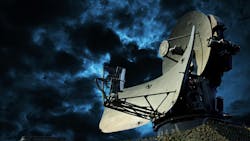How to Design Very Wide Loop BW High-Performance PLL Frequency Synthesizers (Part 1) (Download)
As modern wireless communications systems (mainly superheterodyne radio transceivers) are now required to deliver higher performance than ever before, they’re placing greater demands on the frequency sources for these systems. Such systems are moving higher in frequency (millimeter-wave, or mmWave, and possibly terahertz regions), tuning wider bandwidths (BWs), thus processing more complex waveforms using more elaborate modulation schemes and operating in fast tuning modes.
This is happening in both the commercial and military arenas; examples include satellite communications and repeaters, terrestrial wireless systems such as the present 5G15,16 and eventually 6G17,18 protocols, and tactical line-of-sight radios, among others. Therefore, the frequency sources, and particularly the local oscillators (LOs) for these systems, must also move commensurately higher in frequency and deliver higher performance in terms of low phase noise (the primary interest), low spurious, and fast tuning speed.
